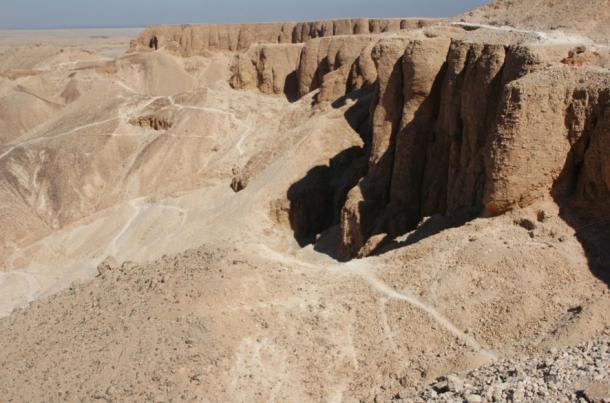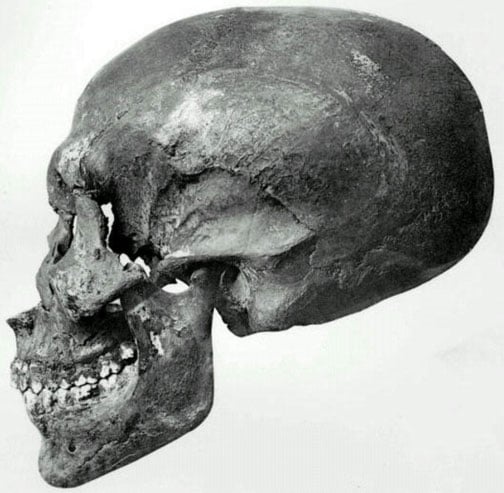
The Mystery of Egyptian Tomb KV55 in the Valley of the Kings
In 1907, a mysterious tomb was discovered in Egypt. Known as KV55, the tomb contained a variety of artifacts and a single body. Identification of the body has been complicated by the fact that the artifacts appear to belong to several different individuals. It has been speculated that the tomb was created in a hurry, and that the individual buried there had been previously laid to rest elsewhere. With many different possibilities for the identity of the mummy – ranging from Queen Tiye (Akhenaten’s mother), to King Smenkhkare – researchers who set out to identify the mummy were presented with a puzzling challenge.
In January 1907, financier Theodore M. Davis had hired archaeologist Edward R. Ayrton and his team to conduct excavations in the Valley of the Kings in Egypt. The Valley of the Kings is an area in Egypt located on the West bank of the Nile River, across from the city of Thebes. Almost all of the pharaohs from Egypt’s “Golden Age” are buried in this famous valley.

Egypt’s famous Valley of the Kings. Source: BigStockPhoto
As Ayrton’s team was working on January 6, 1907, they discovered the entrance to a tomb – KV55. They notified Davis the next day, and began removing the rubble blocking the entrance. On January 9, Davis and Ayrton entered the tomb, accompanied by Joseph Lindon Smith and Arthur Weigall. Over the next few days they took photographs of the items within the tomb and began removing artifacts. By January 25, they were able to view and investigate the coffin and the skeletal mummy within the tomb.
The KV55 tomb is fairly small and simple. The entrance includes a flight of 20 stairs. At the time of the discovery, the entrance and stairs were covered by rubble which all had to be removed. A sloping corridor leads to the tomb, which contains a single chamber and a small niche. Within the tomb, at the time of discovery, were four canopic jars, a gilded wooden shrine, remains of boxes, seal impressions, a vase stand, pieces of furniture, a silver goose head, two clay bricks, and a single coffin. The coffin had been desecrated, with parts of the face having been removed.

Layout of Tomb KV55. Wikimedia, CC BY-SA 3.0
Overall, the physical appearance of the tomb is unremarkable. However, the contents became more puzzling and mysterious as they were examined, as each piece appeared to be connected to different individuals. This made efforts to identify the remains within the tomb more difficult. According to some researchers, the presence of this variety of items indicates that whoever was entombed here was done so in a hurry, or possibly the individual was buried somewhere else, and then relocated to KV55 at a later date.

One of the four Egyptian alabaster canopic jars found in KV55, depicting what is thought to be the likeness of Queen Kiya. Wikimedia, CC BY-SA 2.5
While identifying the remains in the tomb has been challenging, there are many clues in the items found within the tomb. Many of these items have been linked to King Akhenaten. The four canopic jars within the tomb were all empty. They contained effigies of four women, believed to be the daughters of Akhenaten, and may have been created for Kiya, one of Akhenaten’s wives. The gilded shrine appeared to have been created for Akhenaten’s mother, Queen Tiye. And Akhenaten’s name was on the two clay bricks.
Davis’ first impression, after in situ examinations were conducted by physicians, was that the remains belonged to Queen Tiye. Evidence that the remains were female included the positioning of the arms, post-mortem damage to the pelvis, and lack of male genitalia. Later it was proposed that the coffin could have belonged to Nefertiti, Meketaten, or Meritaten. Eventually, it was agreed that the coffin was initially created for Kiya. However, upon further study and tests of the remains, researchers concluded that the individual buried within the tomb was, in fact, male.

Profile view of the skull recovered from KV55. Public Domain
Even after it was determined that the remains were those of a male, there remained questions as to who he was, and how old he was when he died. Scientific testing revealed that he may have been closely related to King Tutankhamen, who is believed to have been Akhenaten’s son.
Another theory was that the remains belonged to Smenkhkare, who may have been Akhenaten’s successor. The remains were first estimated to belong to a man who died around the age of 25, but it was later determined he would have been closer to 20 at the time of death.
Anatomist Grafton Elliot Smith suggested that the man may have suffered from a condition that would have delayed maturation of his skeleton, known as Frölich's syndrome, in addition to chronic hydrocephalus. However, later examinations showed no abnormalities in the skull or skeleton. While the skull’s shape was unusual, it was not abnormal. In February 2010, further testing of the remains was conducted, with the age established at approximately 35 years at the time of death. Through scientific studies, researchers were able to make various connections to determine the gender, age, and identity of the mummy located in KV55. Those who created and later altered the tomb certainly did not make that easy.
As of February 2010, scientists declared with near certainty that the skeletal remains in KV55 are in fact Akhenaten himself, the son of Amenhotep III, and the father of King Tutankhamen. This determination was made more than 100 years after the tomb was discovered. For now, the “almost certain” determination that the mummified remains belong to Akhenaten are the conclusion to this mysterious find.

Bust of Pharaoh Akhenaton (Wikimedia Commons)
Attempts have been made to recreate the circumstances that led to this mysterious, hasty burial. It is possible that Queen Tiye upset Amenhotep III’s burial plans when she outlived him by 12 years.
Akhenaton, originally named Amenhotep IV, was one of the most radical pharaohs of Egypt. The father of Tutankhamun, was a revolutionary who is noted for abandoning traditional Egyptian polytheism and introducing the first monotheistic religion centered on the one ‘true’ god of Aten (the Sun disk), so it is also possible that Akhenaten’s later reputation as ‘heretic king’ led workmen to hastily remove other sarcophagi, such as Queen Tiye’s, from Akhenaten’s presence, leaving him alone in the damaged tomb.
Although we can be confident that the remains belonged to Akhenaten, we may never know the exact circumstances that led to the presence of his isolated remains in this mysterious tomb.
Featured image: The desecrated royal coffin found in Tomb KV55. Wikimedia, CC BY 2.0
Sources
The Mystery of the Mummy in Tomb #55 – Historic Mysteries. Available from: http://www.historicmysteries.com/the-mystery-of-the-mummy-in-tomb-55/
Mystery of the Mummy from KV55 – Guardian. Available from: http://www.guardians.net/hawass/articles/Mystery%20of%20the%20Mummy%20from%20KV55.htm
KV 55 (Tiye or Akhenaten?) – Theban Mapping Project. Available from: http://www.thebanmappingproject.com/sites/browse_tomb_869.html
By M R Reese
















Comments
The KV55 mummy is a female and it is of the 18th dynasty it is related to king tutankamen and Akenatem as the body is of anaksenumun. She has been trapped in the underworld because she knew that Aye killed king Tut. She had to marry Aye, then was killed by Aye, as Aye accused her of killing her first husband and brother king Tut.
Ana bi anaksenumun
The KV55 mummy is a female and it is of the 18th dynasty it is related to king tutankamen and Akenatem as the body is of anaksenumun. She has been trapped in the underworld because she knew that Aye killed king Tut. She had to marry Aye, then was killed by Aye, as Aye accused her of killing her first husband and brother king Tut.
Ana bi anaksenumun
Just a couple of years ago DNA tests of many of the Amarna royals were done. To the best if my recollection the mummy in KV 55 was related to Khia. Nothing accurate is known when Akhenaten died, however it is known that he was never buried in the tomb prepared for him in Amaranth. Since he and his immediate family were so hated it is probable that burials were done hurried and in secret.
I want the KV 55 mummy to be Shmenkare. He died before Tut who had this sumptuous burial that also had many burial articles that were supposedly intended for Nefertiti. Since it is assumed that Tut's tomb has two more hiddden rooms, if those are opened we may have better information about this whole affair.
I guess the egyptians didnt at all think about rain out there, since they had their sarcophagus' at the bottom, where rain would fill it in. but then how would it dry out ? or drain off ?
why wouldn't they have had some kind of water pit ? After all they knew he would be down there in the underworld, therefore why not have the assumption that rain may come some day and ruin all they were preparing..? They thought of soo many things too..
Akhenaton was probably buried in his own city of Akhetaten - so this must have been a relocation of sorts like the mummy cache - such a Pharoah would not have had such a simple tomb & if Tut's tomb was anything to go by it must have been extremely sumptuous especially considering the aesthetics of the 18th Dynasty see Nerfertiti's bust . They do not say the body disintegrated upon opening the coffin ....also there was a lot of water damage. As the first man to worship One God in history - Akhenaton was definitely different and physically extremely different......maybe a hybrid 'giant'......anyways his images although defaced and shattered survived in rubble and in the abandoned City at Tel Amarna and used for Temple filling at Karnak for posterity. Akhenaton was propablynthe inspiration for later Judaism - many of the verses in the tombs of Amarna are later reflected in Psalms .....and his link to Yuya the Wizier ( Joseph ???) it's all which came first the chicken or the egg......& his Queen Nerfertiti well ......ps on a side note it has been noted that more Brits share DNA with Tut's and thus by default Akhenaton than modern Egyptians.
Pages